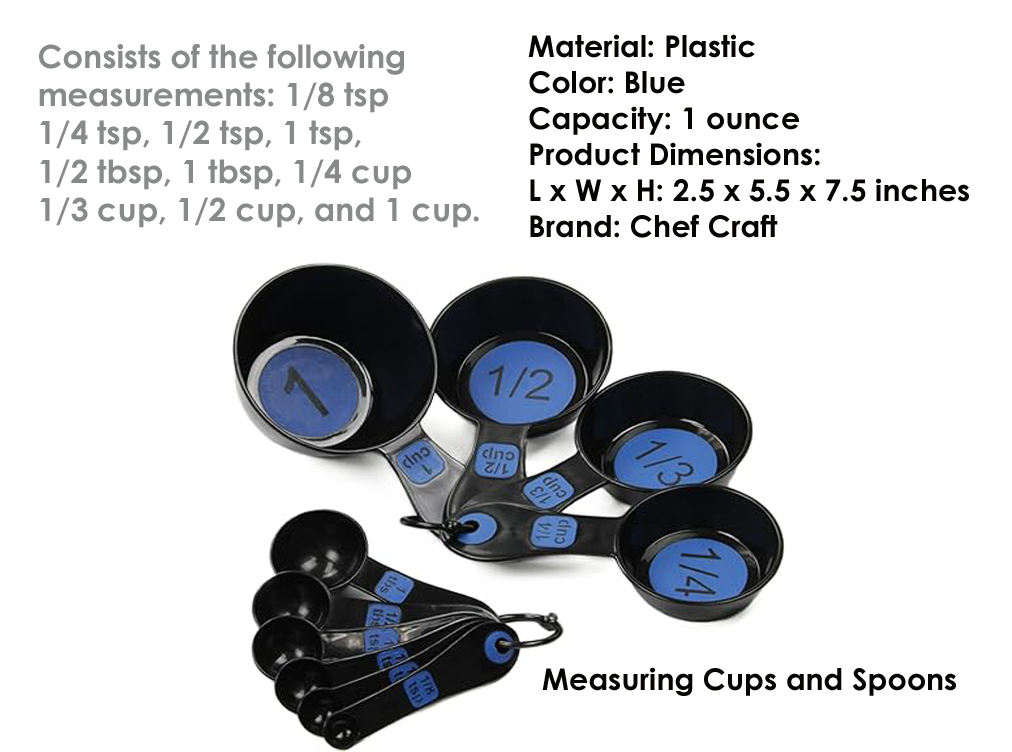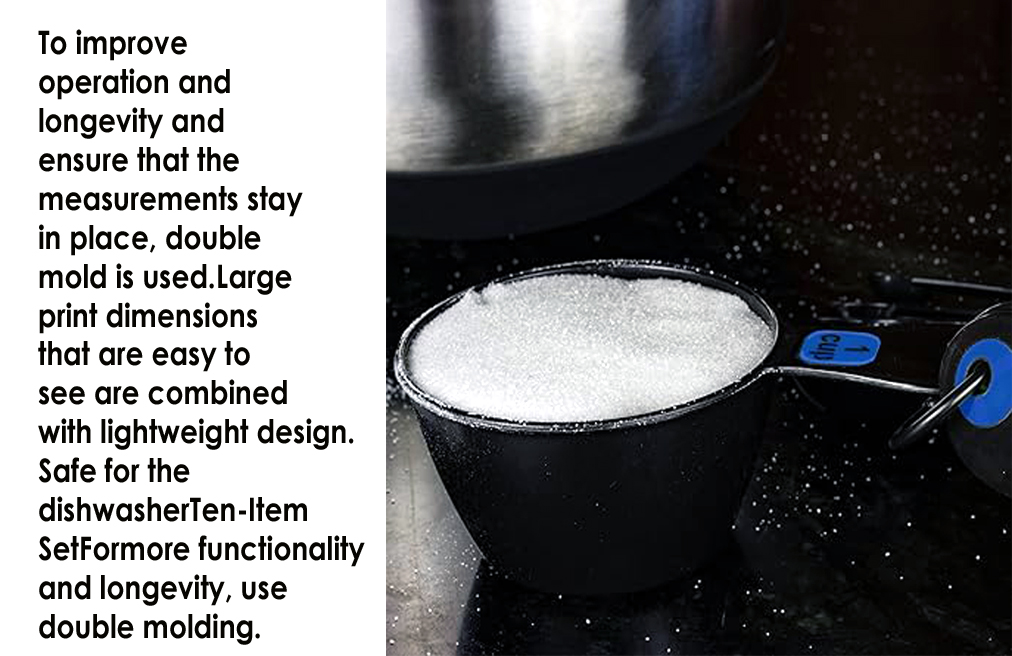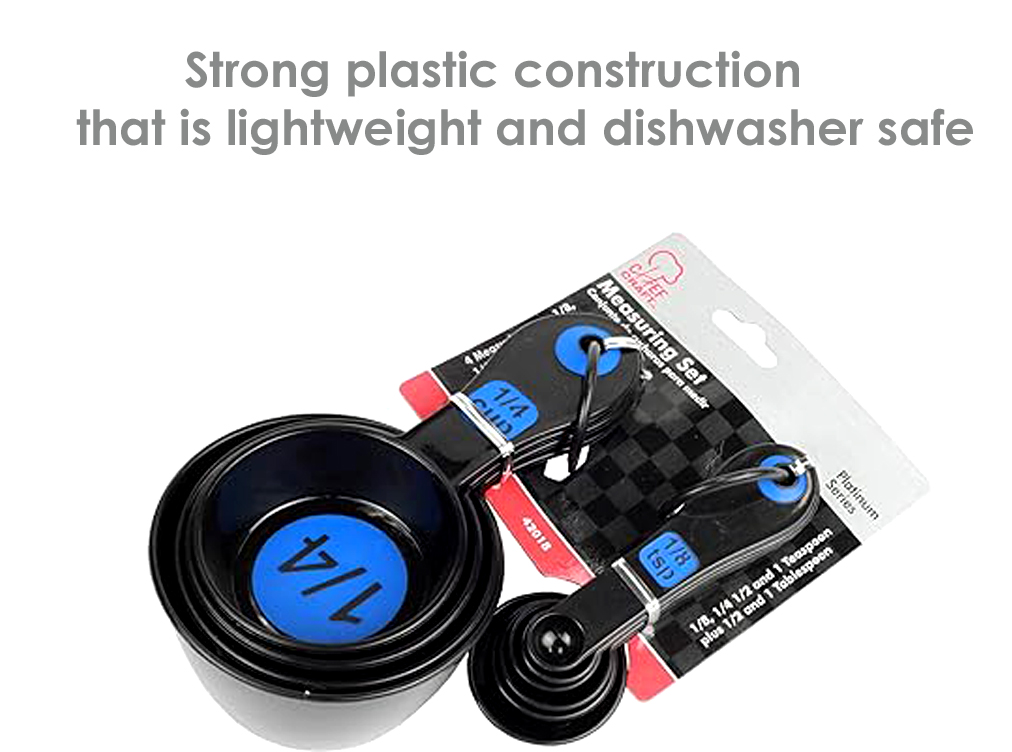Introduction
Your Guide to Measuring Cups and Spoons In the grand orchestra of the kitchen, where spices sing and flames dance, precision is the conductor’s baton. And what instruments ensure harmony in this symphony of flavors? None other than the humble measuring cups and spoons, those tiny titans that define accuracy in every sprinkle and scoop. But with shelves overflowing with sets of all shapes and sizes, finding the perfect match can feel like deciphering an ancient culinary code. Fear not, intrepid kitchen explorers, for this deep dive into measuring cups and spoons will be your map, guiding you through features, materials, and functionalities to discover the ideal set for your culinary adventures.
The Measure of Mastery:
- Size Symphony: From the whisper-soft 1/8 teaspoon to the booming one-cup chorus, a comprehensive set caters to the full spectrum of culinary needs. Dry or liquid, delicate or hearty, you’ll have the right tool for every ingredient, ensuring precision in both grandma’s secret cookie recipe and that trendy molecular gastronomy experiment.
- Material Matters: Plastic, stainless steel, or silicone? Each boasts its own strengths and weaknesses. Plastic, the budget-friendly troubadour, is lightweight and stain-resistant but may lack the durability of its metallic counterparts. Stainless steel, the knight in shining armor, offers long-lasting strength and dishwasher-safe convenience, but its heft can be daunting for delicate tasks. Silicone, the nimble jester, dances between heat and cold with ease, but its markings can fade over time. Consider your needs: are you a baking bard who craves everyday convenience or a culinary alchemist seeking premium longevity?
- Design Delights: Form and function intertwine in the perfect set. Look for ergonomic handles that fit comfortably in your hand, even after hours of mixing and measuring. Clear, easy-to-read markings banish the squinting blues, preventing disastrous flour overloads and thimble-sized dollops of honey. Bonus points for nesting cups and stackable spoons that keep your drawers organized and your sanity intact.


| Aspect | Measuring Cups | Measuring Spoons |
|---|---|---|
| Pros | ||
| 1. Volume Accuracy | Provides accurate measurements for liquids | Offers precise measurements for small quantities |
| 2. Versatility | Suitable for measuring both dry and liquid ingredients | Ideal for small amounts of liquid or dry ingredients |
| 3. Ease of Use | Easy to pour and level off ingredients | Convenient for reaching into narrow containers |
| 4. Standardization | Commonly used in recipes, ensuring consistency | Universally accepted for smaller measurements |
| 5. Graduated Markings | Clearly marked with measurement indicators | Clearly marked for different measurements |
| 6. Accessibility | They are widely available and come in various materials | Readily available in kitchen utensil sets |
Cons: 1. Limited precision. May not be as precise for small quantities. Less suitable for measuring larger volumes accurately
2. Bulkiness. Takes up more storage space. It may be more challenging to store neatly in some cases.
3. Cleanup. Can be challenging to clean, especially for sticky ingredients. It requires extra care to clean due to small size
Chef Craft’s 10-Piece Set: A Culinary Case Study
Now, let’s put theory into practice! We’ll dissect Chef Craft’s 10-piece measuring cup and spoon set, examining its features, performance, and overall value to determine if it’s a worthy companion on your culinary quest.

Unboxing the Arsenal:
- Tenacious Ten: This set boasts a range of ten instruments, from the delicate 1/8 teaspoon to the generous one-cup measure, ensuring precision for both dry and liquid ingredients. Whether you’re whipping up a single-serving soufflé or feeding a ravenous feast, you’ll have the right tool for the job.
- Plastic Powerhouse: Chef Craft opts for durable, BPA-free plastic, a budget-friendly choice that’s lightweight and dishwasher-safe. While it may not possess the heft of stainless steel, it shines with easy handling and stain resistance. Perfect for everyday cooks who value convenience and affordability.
- Double-Duty Design: The double-molded construction locks in markings, preventing the frustration of faded measurements. Large, easy-to-read numbers ensure even the sleepiest chef avoids floury mishaps.
Performance in the Culinary Cauldron:
- Baking Bonanza: Let’s test the mettle of this set with a classic: chocolate chip cookies. The cups handle dry ingredients with grace, while the spoons dole out precise amounts of wet magic (vanilla extract, anyone?). Clear markings eliminate guesswork, and the 1/2 cup size proves perfect for scooping that magical dough. Victory in the cookie jar is assured!
- Cleaning Up the Battlefield: After the culinary conquest, the dishwasher-safe construction makes cleanup a breeze. No more scrubbing away at stubborn remnants; toss these warriors into the dishwasher and let them soak in the glory of a successful bake.
The Verdict: A Champion for Budget-Conscious Cooks
Chef Craft’s 10-piece set emerges as a champion for budget-conscious bakers and casual cooks. Its durable plastic construction, functional design, and clear markings offer accuracy and convenience, making it a valuable asset for any kitchen. While it may not suit those seeking premium materials or a lifetime commitment, this set is a well-rounded soldier ready to conquer everyday culinary challenges.


Conclusion
Ah, measuring cups and spoons—the unsung heroes of the kitchen, quietly ensuring harmony in the symphony of flavors. Whether you’re a seasoned chef orchestrating complex culinary masterpieces or a fledgling foodie whipping up your first batch of brownies, precision is key. And that’s where these tiny titans come in, wielding accuracy in every sprinkle and scoop.
But navigating the vast world of measuring sets can feel like deciphering an ancient recipe. Plastic, stainless steel, and silicone—each material boasts its own strengths and quirks. Sizes dance from the delicate whisper of a 1/8 teaspoon to the booming chorus of a 1-cup measure. And let’s not forget the design delights, from ergonomic handles to stackable spoons, all vying for a place in your drawers.
Fear not, culinary adventurers! This guide is your map, leading you through the features, materials, and functionalities of measuring cups and spoons. We’ll explore pros and cons, delve into popular sets, and ultimately help you find the perfect match for your kitchen symphony. So grab your whisks and spatulas, because it’s time to conquer the culinary chaos and unlock delicious triumphs, one precise measurement at a time!
Stay tuned for our next segment, where we’ll dive deeper into the different materials and their pros and cons!
(FAQs)
Q: Can I use a regular cup from my kitchen for measuring ingredients?
While you can use a regular cup, it’s recommended to use specific measuring cups as they provide accurate volume measurements, ensuring precise results in recipes.
Q: Are measuring cups suitable for both dry and liquid ingredients?
Yes, measuring cups are versatile and can be used for both dry and liquid ingredients. They typically have markings for various volume measurements.
Q: Can I substitute measuring cups and spoons for regular teaspoons and tablespoons?
Measuring cups and spoons provide accurate measurements, but in a pinch, you can use regular teaspoons and tablespoons. However, be cautious, as the measurements may not be as precise
Q: How do I measure sticky ingredients like honey or peanut butter with measuring cups?
To measure sticky ingredients, coat the measuring cup with a thin layer of oil or cooking spray. This will help the ingredient slide out easily.
Q: Are plastic measuring cups and spoons as accurate as metal ones?
Both plastic and metal measuring cups and spoons can be accurate, but the key is to choose high-quality ones with clear markings to ensure precision.
Q: How should I clean measuring cups and spoons?
It’s best to hand wash measuring cups and spoons with warm, soapy water. Some are dishwasher-safe, but prolonged exposure to high heat may affect their accuracy.
Q: Are there measuring cups for small quantities?
Measuring spoons are designed for small quantities, typically ranging from 1/8 teaspoon to 1 tablespoon. They offer precision for recipes that require small amounts of ingredients.
Q: Can I use liquid measuring cups and spoons for dry ingredients?
While it’s possible, it’s better to use dry measuring cups for dry ingredients. These cups allow you to level off the ingredient for accurate measurement
Q: Can I mix different measuring cup and spoon sets in my kitchen?
It’s best to use a consistent set for accurate measurements. Mixing sets may result in variations in measurements due to differences in design and markings
